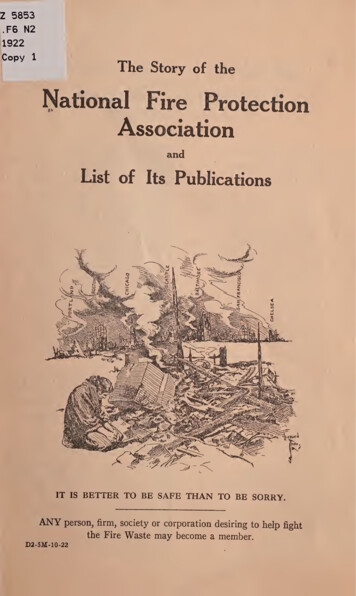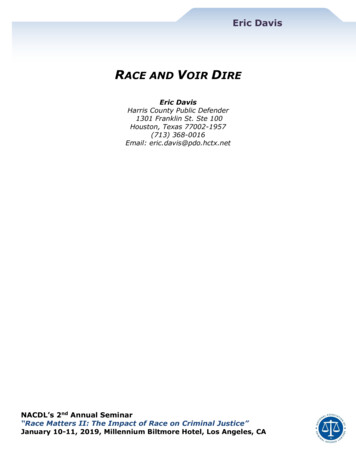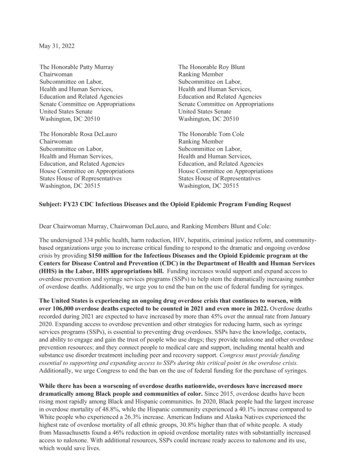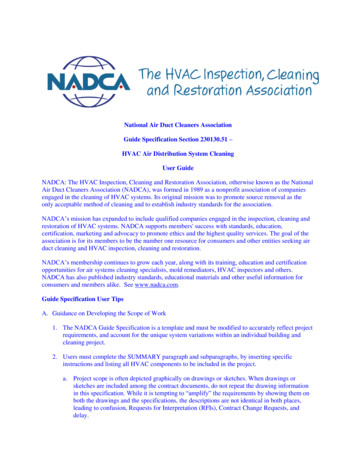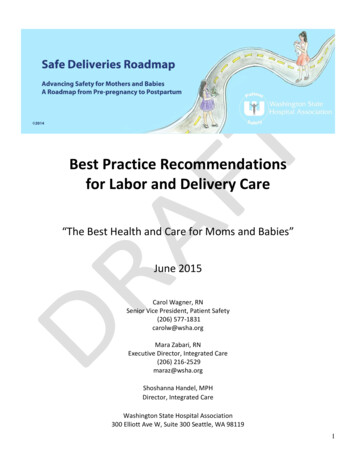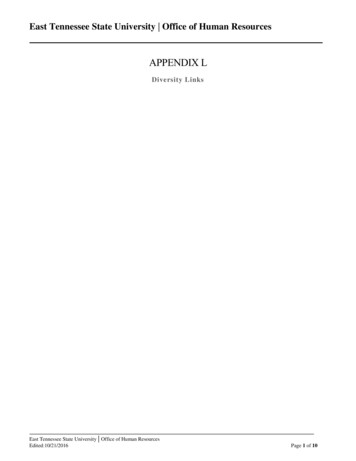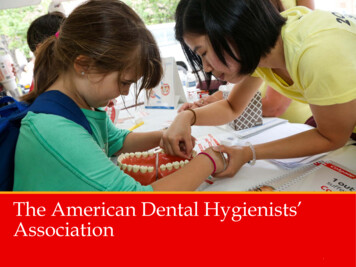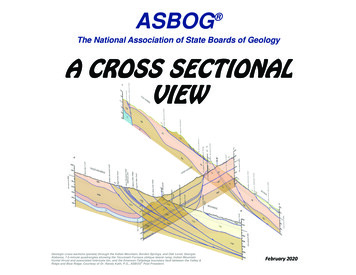
Transcription
ASBOG The National Association of State Boards of GeologyA CROSS SECTIONALVIEWGeologic cross sections (panels) through the Indian Mountain, Borden Springs, and Oak Level, GeorgiaAlabama, 7.5-minute quadrangles showing the Tecumseh Furnace oblique lateral ramp, Indian Mountainfrontal thrust and associated imbricate fan, and the Emerson-Talladega boundary fault between the Valley &Ridge and Blue Ridge. Courtesy of Dr. Randy Kath, P.G., ASBOG Past President.February 2020
From the PresidentASBOG continues to work diligently on the organizations’ four major goals: 1) increase attendance and diversity of participants at the Council of Examiners (COE) Workshops; 2) better align ASBOG with other organizations within the geosciencescommunity; 3) increase participation in FG and PG examinations; and 4) continue to improve communications with, and between, our Member Boards. To this end, we are pleased to introduce the 3rd edition of A Cross Sectional View, an ASBOG publication that captures statistical data related to exam development, administration and performance. This publication presentsan annual snapshot of accomplishments of the ASBOG organization illustrating its basis, mission, member boards, and relateddemographics. It is our goal for A Cross Sectional View to provide our Member Boards a better understanding of the trends inlicensure and health of the organization.This year’s ASBOG annual meeting and COE workshop is being held in Madison, Wisconsin, bringing ASBOG back toAmerica’s Dairyland after 23 years. If you’re a Member at Large (MAL) or State Board Member (MBR) who hasn’t participatedin the COE workshop for a while, consider joining us in Madison. If you’re a licensed/registered Geologist who’s been thinkingabout participating, please contact ASBOG for more information about how you can get involved. And to all of the individualsand Member Boards that have contributed to the success of ASBOG over the years, your efforts and support are very much appreciated. Thank you.Brenda Halminiak, P.G.2020 ASBOG PresidentStatementThe Mission of the National Association of State Boards ofGeology (ASBOG ) is to serve as a connective link for theindividual state geologic registration licensing boards for theplanning and preparation of uniform procedures and the coordination of geologic protective measures for the general public.One of ASBOG 's principal services is to develop standardizedwritten examinations for determining qualifications of applicants seeking licensure as professional geologists. Examinationcandidates are provided with a copy of the Professional Geologists Candidate Handbook which delineates the format andoutline for the examination.ASBOG administers the Fundamentals of Geology (FG)and Practice of Geology (PG) Examinations twice each year.The FG and PG examinations were developed to evaluate common knowledge and skills related to the practice of geology.The FG examination emphasizes knowledge and skills that aretypically emphasized in undergraduate academic programs,and the PG examination emphasizes skills and knowledge acquired and expanded in a practice or job setting. Participatingstates administer each “closed-book” examination during afour-hour period. Both examinations are constructed using afour-option multiple choice form, and the FG and PG examina-tions contain approximately 140 and 110 items, respectively.Both examinations are based on the results of periodic taskanalysis surveys (TAS) that are designed to evaluate the current geologic practice. Task analysis surveys have been performed every five years since 1995 by collecting data from arandom sampling of licensed geologists from each of the ASBOG member states. The results of all five task analysis studies indicate a high degree of consistency in the practice of Geology throughout the United States and Canada, thereby establishing a sound basis for the development of examinations thatare fair to candidates from all regions of the country.Geologic tasks were rated by both practicing geologists andacademicians in terms of the importance of the specific tasks toprotection of the public, and the results of the survey were utilized to create test blueprints for both examinations that temporally and geographically reflect the practice of the profession.The eight (8) established Content Domains for the FG and PGTest Blueprints are listed in the Candidate Handbook.
What is a geologic cross section?A geological cross section is a graphical representation of a vertical slice through the earth used to clarify or interpret geological relationships with or without accompanying maps.There are two major classes of cross sections: Structural cross section, which shows the present day geometry of an area; Stratigraphic cross section, which shows the prior geometric relationships by adjusting the elevation of geological unitsto some chosen geological horizon.There are other variations of cross sections, the most common being a balanced cross section (a combination of structural andstratigraphic cross sections), that attempts to portray the form of geological units prior to some episode of structural deformation.Geologic map and cross section along the South River Tunnel, DeKalb County, Georgia. Courtesy of Dr. Randy Kath, ASBOG Past President and Coordinator of theAcademic Assessment Program.
ASBOG Who we areThe National Association of State Boards of Geology (ASBOG ) is a national nonprofit organization committed toadvancing professional licensure for geoscientists.Professionally licensed geoscientists have met specific qualifications in education, examination, and work experience and are professionally charged to work in a manner that safeguards and protects the public’s health, safety, andwelfare.
ASBOG What we doASBOG facilitates the mobility for professional geoscientists in the United States by providing services to itsmember licensing boards including examination development, examination maintenance, and the overall mobility ofprofessional geoscientists. These services include promoting the uniformity of licensure laws across the U.S. in theattempt to facilitate geoscientists to become licensed.Fall field trip, Minnehaha Falls, Minneapolis, MN 2019SMEs on field trip near Minneapolis, MN 2019SMEs on field trip near Alton, NH 2019SMEs on field trip near Alton, NH 2019
ASBOG Examination DevelopmentThrough its Council of Examiners (COE) and statisticians, ASBOG has independently createdtwo national geoscience examinations: the Fundamentals of Geology Exam (FG) and the Practiceof Geology Exam (PG).Licensed geoscientists volunteer their time and experience to examination development andmaintenance by coming to ASBOG Council of Examiners Workshops to write and evaluate examination questions and answers. In 2019, there were 110 Subject Matter Experts (SMEs) hailingfrom 27 Member States, 2 non-member States, and the District of Columbia that participated intwo semi-annual ASBOG Workshops. This represents over 3,500 hours spent on developing andevaluating examinations for both of ASBOG ’s examinations. In addition to having strong geographic representation, the SMEs bring a diverse set of technical skills that cover each of the eight(8) content domains: A) General and Field Geology; B) Mineralogy, Petrology, and Geochemistry;C) Sedimentology, Stratigraphy, and Paleontology; D) Geomorphology, Surficial Processes, andQuaternary Geology; E) Structure, Tectonics, and Seismology; F) Hydrogeology; G) EngineeringGeology; and H) Economic and Resource Geology.Subject Matter Experts work with a psychometrician to re-evaluate examination and examination question statistics and to select and edit examination questions. Based on results of the COEWorkshop, the psychometrician determines final scores for the recently administered national examinations, and adds new questions to the item bank for use in future examinations.The examinations are administered twice a year, the Spring examination is the 3rd Friday ofMarch; the Fall administration is the 1st Friday of October.
ASBOG Examinations Administered
Examination Performance & Passing Rates
ASBOG 2016 Candidate Handbook
The Fundamentals of Geology (FG) Examination
The Practice of Geology (PG) Examination
ASBOG Top UniversitiesTop 12 Universitiesby FG examination volumeMany universi es recognize the value of licensure and encouragetheir students to take the FG during the final semester of theirsenior year or as soon a er gradua on as possible.
ASBOG Using the FG for Academic AssessmentAs with other professional licensure testing organizations, the Fundamentals of Geology examination has been utilized as an assessment tool for universities/colleges. Over the past 22 exam administrations, there have been 514 institutions of higher learning whose students have taken the FG examination with the total number of examinees totaling nearly 9,528 over that period. In addition, there now exists a software analysis program (Curriculum PerformanceAssessment Tool or CPAT) developed by Past President Dr. Randy Kath available to those institutions that want toassess their department and student performance on the FG examination.There are currently 237 institutions with 10 or more examinations in the CPAT database. This is an increase from217 institutions with 10 or more examinations from last year. This accounts for the 8,569 records (tests) stored inCPAT. There are many institutions that have 8 or 9 tests and we anticipate that these will be added to the CPAT database when the results from the next administration of the FG examination become available.Academic Assessment is an integral part of ASBOG ’s outreach to academic institutions. The primary objectiveof Academic Assessment is to support academia through promotion of CPAT for use of the ASBOG FG Examination as an assessment tool, exit examination, and/or graduate school entrance examination. CPAT support has beenprovided to the following institutions: Appalachian State UniversityArkansas Tech UniversityAuburn UniversityBaylor UniversityBloomsburg UniversityCalifornia State Univ– BakersfieldCalifornia State Univ– FresnoCalifornia State Univ– FullertonCalifornia State Univ– NorthridgeCalifornia State Univ– San BernardinoCalifornia State Univ– SacramentoCalifornia State Univ- StanislausCalifornia University of PennsylvaniaCentral Michigan UniversityEastern Kentucky UniversityEastern Washington University East Carolina UniversityFort Hayes State UniversityGeorgia State UniversityIowa State UniversityJames Madison UniversityKansas State UniversityMillersville University (PA)Mississippi State UniversityNorthern Arizona UniversityNorthwest Missouri StateSan Francisco State UniversitySan Diego State UniversitySonoma State UniversityTexas A & MTexas Tech UniversityUniversity of Arkansas- Little Rock University of California- DavisUniversity of California– Santa CruzUniversity of DelawareUniversity of GeorgiaUniversity of PittsburghUniversity of Pittsburgh- JohnstownUniversity of South Florida– TampaUniversity of South AlabamaUniversity of West GeorgiaUniversity of WyomingUtah State UniversityVirginia Tech UniversityWeber State UniversityWest Chester UniversityWestern Oregon UniversityWestern Washington University
ASBOG Curriculum Performance Assessment Tool (CPAT)More than 70% of all candidates taking the Fundamentals of Geology examina on are gradua ng seniors (nodegree) and/or B.A./B.S. graduates;allowing for the use of this na onalexamina on for undergraduate program review, program modifica onand curriculum assessment.As an example, Chimney Rock University(fic ous) contains more than 10 examinaons in the CPAT database; therefore, it issta s cally valid for CPAT to compare thecandidates performance on the Fundamentals of Geology examina on to the na onalexamina on performance.The main CPAT menu (right) provides summary sta s cs for the school’s performancerela ve to the na onal average. Z-Scores,Percen les, Percent Passing by Degree Yearand other data are available.CPAT
ASBOG Curriculum Performance Assessment Tool (CPAT)Z-Scores (le ) can be used to show the sta s cal performance of candidates that are grouped by gradua on year. Scores above zero indicate the number of standard devia ons above the na onal mean,whereas scores below zero indicate the number of standard deviaons below the na onal mean.The Fundamentals of Geologyexamina on is broken into eightcontent domains. CPAT allowsfor a detailed evalua on of domain-specific performance for adepartment by using differentsta s cal evalua on plots basedon user selected variables (le ).Normalized ra o plots allow comparison of a school’s aggregatedomain-specific scores rela ve to the na onal domain score per testadministra on (right). These are grouped by gradua on year asshown.
Na onal Associa on of State Boards of GeologyP.O. Box 5219Douglasville, Georgia 30154Tel: 678-713-1251Web: h ps://asbog.orgThis document was compiled and edited by Dr. Randy Kath, P.G., ASBOG Past President and Director ofthe Academic Assessment program.
ASBOG administers the Fundamentals of Geology (FG) and Practice of Geology (PG) Examinations twice each year. The FG and PG examinations were developed to evaluate com-mon knowledge and skills related to the practice of geology. The FG examination emphasizes knowledge and skills that are typically emphasized in undergraduate academic programs,



